Key Points:
- All nine venomous snake species in California are different types of rattlesnake.
- Western diamondbacks are infamous for having some of the most potent venom of all snakes and possess fangs that are over a half-inch long, enabling the snake to deliver more venom in one bite.
- Sidewinder snakes can move up to 18 mph in the sand by using a unique method of hurling their bodies sideways instead of the usual slithering.
California is one of the most popular places in the world, let alone the United States. This is partly because of its sunny climate, large size, and diverse ecosystems. So naturally, all of these things together mean that the Golden State is sure to have a vast array of wildlife.
While this means that there are lots of harmless animals to observe and enjoy, it also includes some species that are a little more dangerous. Both categories include snakes, which are commonly feared as deadly predators that bite anyone that gets near them.
While it’s wise to respect the wildlife and be aware of the local dangers, it’s unnecessary to be afraid of all snakes as a whole. 48 different types of snakes of snake inhabit California, and only nine of them contain venom. Furthermore, each of the nine is a rattlesnake that prefers to scare off aggressors with audible rattles.
There is a lot of hiking, kayaking, and other adventures to be enjoyed throughout the state, and it would be a shame to let the fear of some snakes ruin it. Therefore, we’ve put together a list of some of California’s most notable snakes in hopes that people learn to recognize and understand them. After all, knowledge is power!
Common Snakes in California
Before we dive into the venomous snakes in California, let’s look at some of the more common snakes in the Golden State.
Pacific Gopher Snake
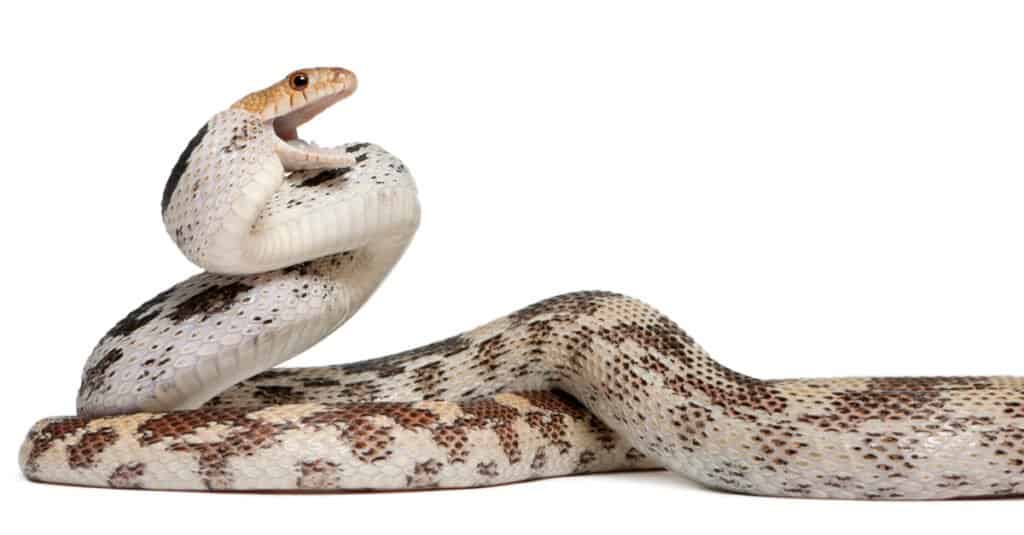
Pacific gopher snakes can grow large but are nonvenomous.
©Eric Isselee/Shutterstock.com
Despite growing to be up to 7 feet long, gopher snakes are nonvenomous and uninterested in humans. They come in colors brown, green, and yellow and have dark spots along with their bodies. Due to their size and coloring, they are often mistaken for rattlesnakes. Their tendency to shake their tails at potential predators doesn’t help things.
However, their behavior is an easy way to tell them apart. While rattlesnakes are reclusive, gopher snakes are a little more free-spirited and may even approach you in short, tight movements. Even if this is terrifying, it’s also an indicator that you’re not in a risky situation, since rattlesnakes move with wider curves and rarely approach people on their own.
Gopher snakes are named for their diet; they love to feast on gophers, as well as other rodents, birds, lizards, bats, and eggs. They have a variety of predators, including foxes, coyotes, and birds of prey. It’s likely that they started shaking their tails to deliberately mimic rattlesnakes to scare off predators, including humans. Whatever they’re doing is clearly working, as gopher snakes are some of the most common snakes in California, particularly in the south. Look for them during sunny days in semi-arid, flat plains, including agricultural areas.
California Kingsnake
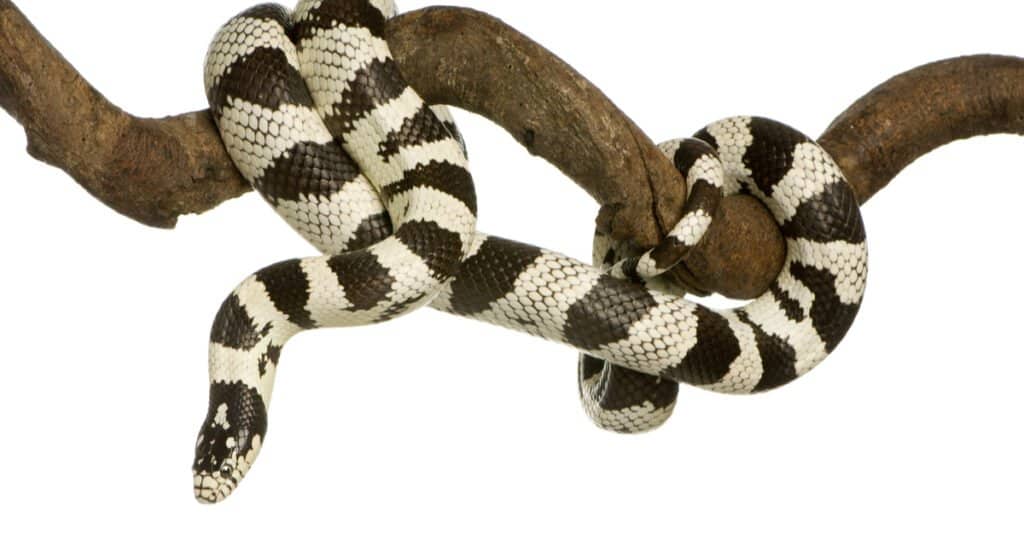
California kingsnakes are found across California.
©Eric Isselee/Shutterstock.com
Kingsnakes are fan favorites among snake owners due to their size and a wide variety of coloring. At 3 to 5 feet, they’re small enough that you needn’t purchase a gigantic terrarium for them to live in. They’re pretty neat to look at too, coming in many different colors and scale patterns.
For example, in Sacramento Valley, they may have lateral stripes, similar to a garter snake. Another snake that they may share patterns and colors with is the venomous coral snake, which gives people quite a scare. However, you needn’t worry, as California has no coral snakes.
These snakes live all over the state and can even be found in urban areas. Like the gopher snake, they may wag their tails to imitate rattlesnakes, but they won’t hurt you unless you persistently harass them. In fact, these guys are important for keeping rattlesnakes in check. Since they’re immune to snake venom, they regularly prey upon rattlesnakes. So if you’re afraid of venomous snakes, leave the kingsnake alone and let it get rid of them for you.
Ring-Necked Snake
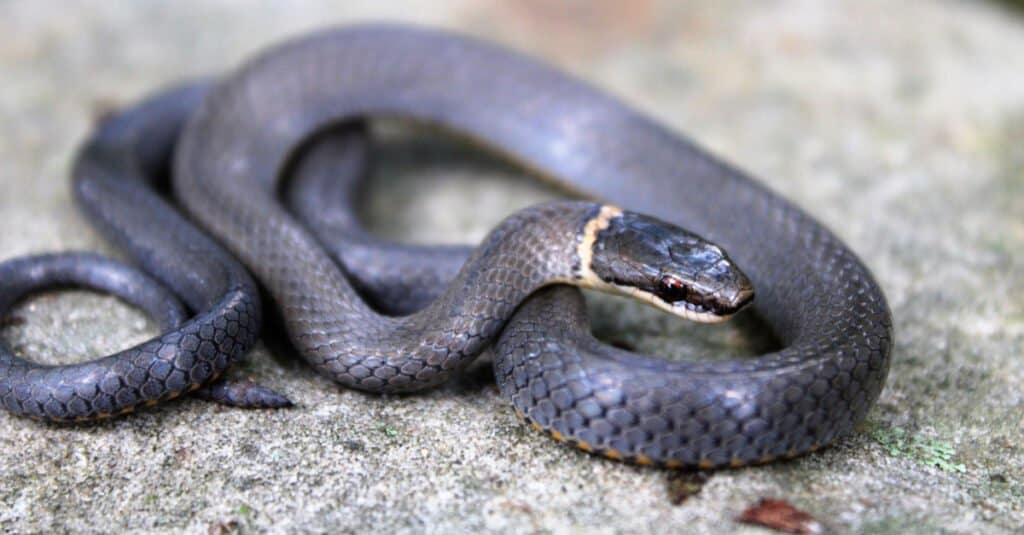
Ring-necked snakes are nocturnal, so you may never see one even if they live near you!
©Tucker Heptinstall/Shutterstock.com
These two-toned snakes can be a challenge to find in the wild. Ring-necked snakes are nocturnal for starters, which helps to mask their dark bodies. They’re also quite fast, meaning that they can take off as quickly as they’re spotted.
This is probably for the best, though, as this snake is hunted by various kinds of predators, including owls, frogs, skunks, and hogs. To find one, look for a small, 10- to 20-inch snake with an orange band around its neck. Fortunately, they are found in all kinds of habitats, including hillsides, marshes, and forests. If you want, you can even own one as a pet!
Although the ring-necked snake is nearly harmless to humans, it does contain a small amount of venom. They inject this venom with their back teeth, and it’s such a small portion that they have to chew on their prey for a while before finishing them off with constriction. This is how it consumes prey such as worms, lizards, slugs, and even small frogs. Fortunately, humans are far too large to ever be jeopardized by this process, but that doesn’t mean it doesn’t hurt!
Nine Venomous Snakes in California
California doesn’t have the variety of venomous snakes that are found in some Southern states. Instead, you only need to be aware of the nine types of rattlesnakes that can be found in the state. The nine venomous snakes in California are:
- Western Rattlesnake (Northern Pacific Rattlesnake)
- Red Diamond Rattlesnake
- Southwestern Speckled Rattlesnake
- Mojave Rattlesnake
- Panamint Rattlesnake
- Diamondback Rattlesnake
- Sidewinder
- Southern Pacific Rattlesnake
- Great Basin Rattlesnake
We’ll detail a few of the more common venomous snakes in California below.
Western Rattlesnake (Northern Pacific Rattlesnake)
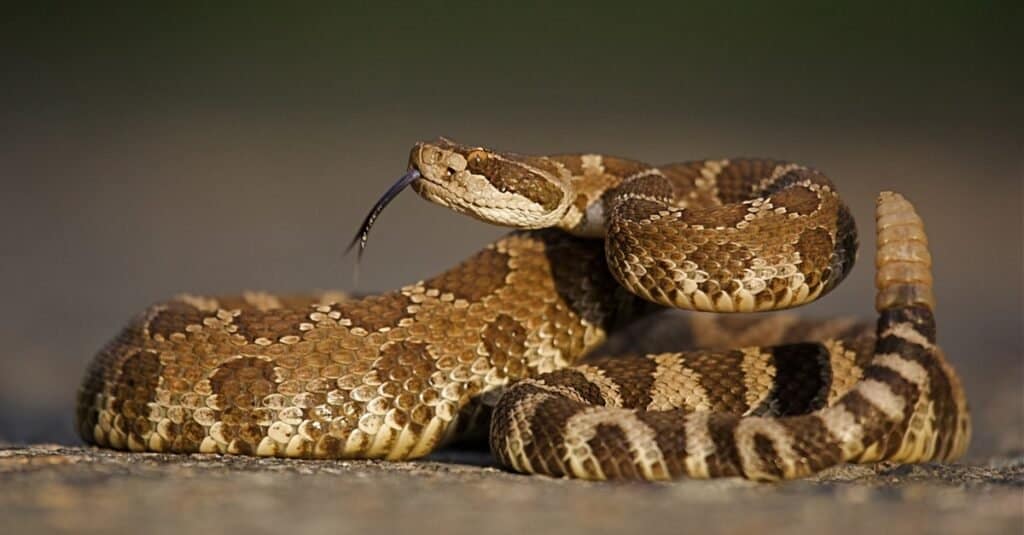
Western rattlesnakes are skilled at blending in with their environment.
©Tom Reichner/Shutterstock.com
These are the most common rattlesnakes in California. They can be found in the northern half of the state, and thanks to their yellow, brown, or gray coloring, they are skilled at blending in with their environment. The best way to avoid them is to listen for their rattles. However, their rattles sometimes break off, so it’s wise to watch out for them as well.
Western rattlesnake venom is very potent, even compared to other snakes, and at 4 to 6 feet, they aren’t exactly small. So it’s understandable that people would be afraid of a reptile with such powerful venom. In fact, humans aren’t alone in this regard; some four-legged mammals, such as deer, horses, and cows, have been known to kill them on sight.
That being said, it’s still too small to eat humans and prefers the standard snake menu of rodents, birds, and eggs. Like all rattlesnakes, they attack only when they feel threatened, so listen for their rattles, keep an eye open, and back off if confronted, and the snake should leave you alone.
Western Diamondback
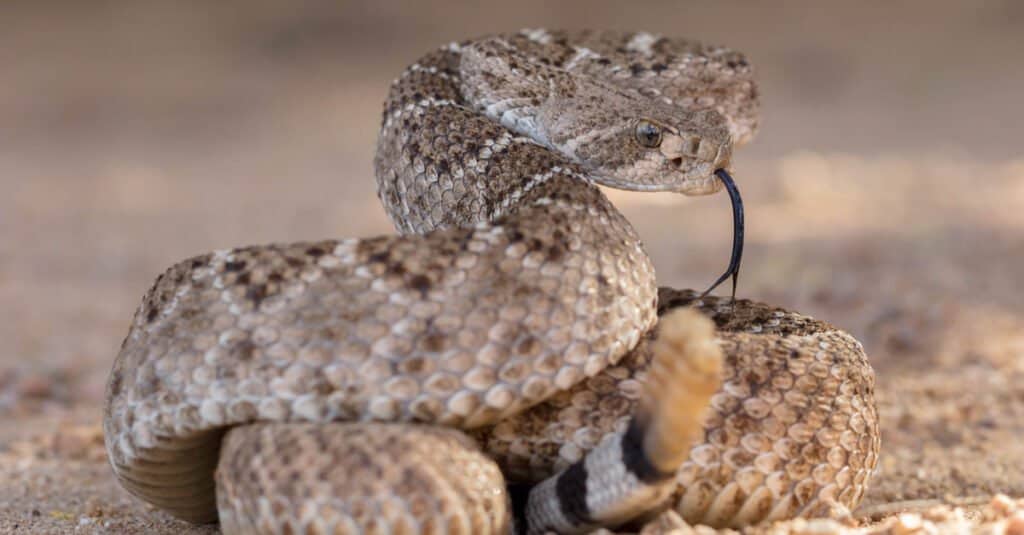
Western diamondbacks have some of the most potent venoms of all snakes.
©Alexander Wong/Shutterstock.com
Western diamondbacks are infamous for having some of the most potent venoms in the snake world. This is in part due to their size, which is typically around 5 feet. Additionally, thanks to their over-half-inch fangs, they can deliver a lot of venom in a single bite. Victims of diamondback bites may experience vomiting, diarrhea, trouble breathing, and increased heart rate. If this snake bites you, get medical attention immediately.
It’s not all bad news, however. For one, when it comes to California, the western diamondback is confined to the dry areas of the southeast, particularly around San Diego and the Arizona and Mexico borders. They’re also easy to identify. If you’re around that area, watch out for their signature diamond-shaped back markings.
Their main bodies are mostly brown, gray, or yellow, though you may see a pink or red one. Their heads are shaped triangularly, and their pupils are elliptical (slit-shaped, like a cat’s). Finally, their rattle is a telltale message to get out. You shouldn’t panic at the thought of running into one, though. They may be more aggressive than other rattlesnakes, but they’re still quite defensive around humans. Leave it alone, and it should leave you alone.
Sidewinder
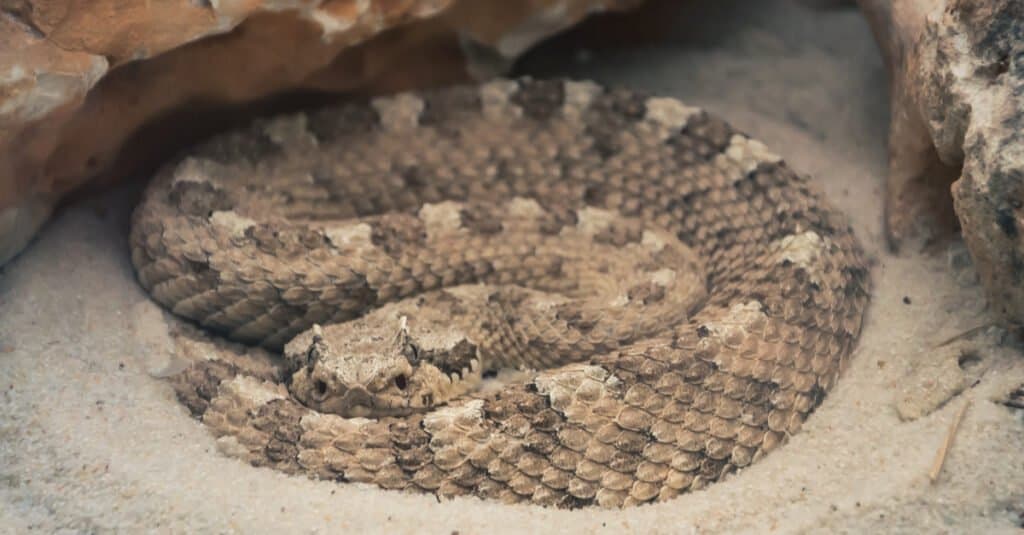
Sidewinders have horn-shaped “eyebrows.”
©RA fotografia/Shutterstock.com
Even at its maximum size of 30 inches, the sidewinder is probably one of California’s least threatening rattlesnakes. Though still deadly, its venom isn’t as potent as the diamondback’s, and because of its size, it delivers less of it per bite.
Furthermore, its habitat is quite small in California, though its native Sonoran Desert extends to Arizona and Mexico. You probably won’t see it, since its variety of colors includes white, gray, tan, and brown, all the colors of sand.
That being said, they are easy to recognize when spotted. If you happen to see one on the move, its unique method of slithering is unmistakable. Rather than wiggle back and forth like most snakes, it will throw its body to the side. Not only is this mesmerizing to watch, but it’s also quite efficient, helping it reach speeds of 18 miles per hour in the sand.
If you happen to get close to one, take a look at its elliptical eyes, and you should notice the horn-shaped “eyebrows” above them. The sidewinder is quite a unique snake in many ways, and we hope that you have an opportunity to see one in person. Just don’t get too close; they’re still dangerous!
What Are the Largest Snakes in California?
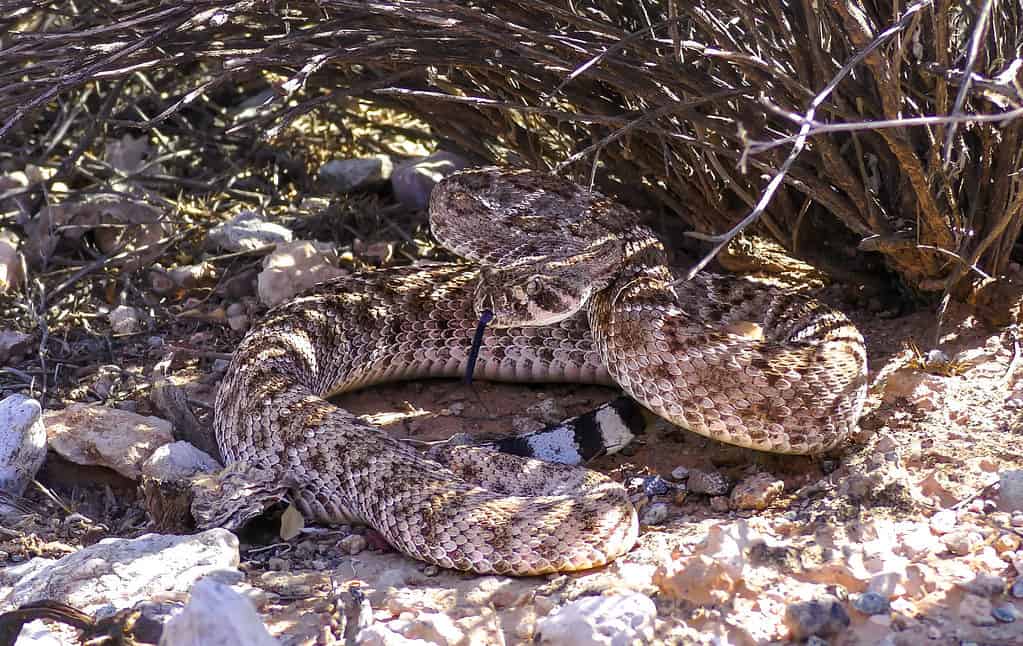
Western diamondback rattlesnakes can reach 6 feet in length.
©iStock.com/Banu R
The largest snake species in California is the western diamondback rattlesnake. It can reach up to 72 inches, or 6 feet, long.
Another large snake present in the state is the giant garter snake. The biggest species of garter snake, it lives up to its name, with adult snakes growing up to 65 inches, or 5.4 feet, long. As is common among snakes, the females are typically longer and larger than the males.
The giant garter snake is found in Central California. In the past, its range extended from Butte County in the north to Kern County in the south, including Sacramento and San Joaquin valleys, but the snake now only inhabits fragmented areas in the Sacramento Valley. As it is semiaquatic, it relies on water to thermoregulate and for food sources (including fish, frogs, American bullfrogs, and tadpoles) and this has been a factor in the fragmentation of its populations.
Despite the development of rice agriculture destroying their wetland habitats, especially of tule marshes, these snakes remain in the same lands, living in the artificial wetlands including rice fields and rice field canals. Giant garter snakes are listed as Vulnerable by the IUCN and a threatened species by the state and federal government due to this habitat loss.
While the western diamondback rattlesnake and giant garter snake are among the largest snake species in the state, a much larger notable individual snake was found in California in 2016. A deceased albino Burmese python that was 17 feet and 7 inches long was discovered in a garbage dump in Riverside, east of Los Angeles. There’s no clear indication how the snake came to be there, but it’s possible it was a pet that died and was disposed of improperly.
Other Snakes in California
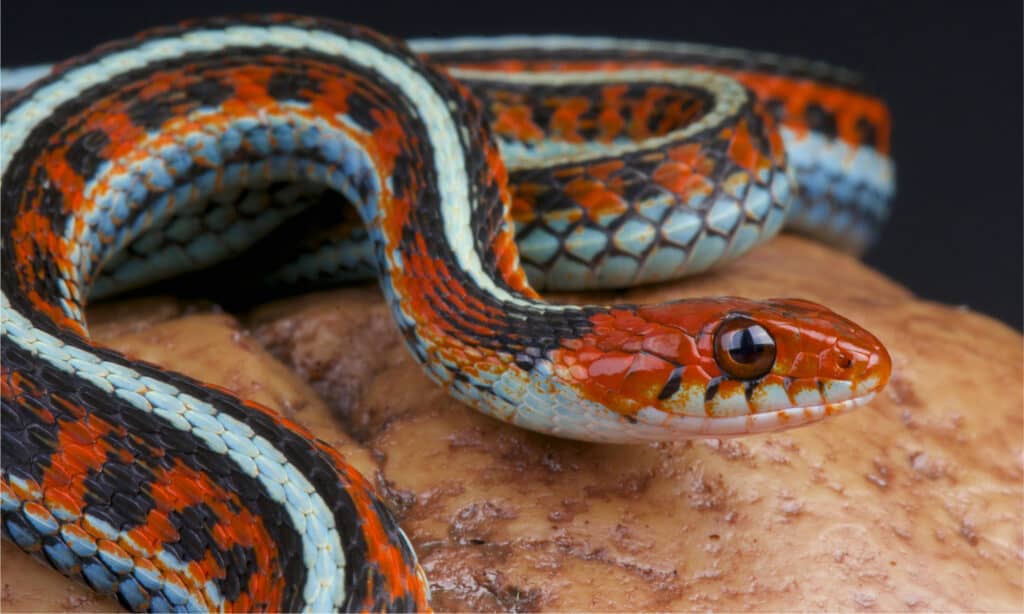
The San Francisco garter snake is the rarest snake in the United States.
©reptiles4all/Shutterstock.com
Snake enthusiasts are always on the watch for the rarest snake in California — and perhaps the rarest snake in North America — the San Francisco garter snake. This strikingly beautiful snake has brightly colored turquoise, black and red-orange scales that look like they were woven to match any southwestern decor. Found exclusively around the San Francisco peninsula area, this California beauty prefers wetlands and grasslands near ponds and marshes to sandy beaches. The San Francisco garter snake is harmless to humans, although venom in its saliva can kill prey it causes nothing more than a mild irritation to human skin. Only a glimpse of these snakes is usually seen in the wild as their instinct is to quickly hide when seen, often by going straight into the water.
Summary of Different Snakes in California
Following is a recap of snakes found in the state of California that we took a close look at:
| Number | Snake | Type | Length |
|---|---|---|---|
| 1 | Pacific Gopher Snake | Nonvenomous | Up to 7 feet |
| 2 | California Kingsnake | Nonvenomous | 3-5 feet |
| 3 | Ring-Necked Snake | Mildly venomous | 10-20 inches |
| 4 | Western Rattlesnake | Venomous | 4-6 feet |
| 5 | Western Diamondback | Venomous | 5 feet |
| 6 | Sidewinder | Venomous | 30 inches |
A Complete List of 46 Different Snakes in California
Here is a listing of the most common snakes found across California:
- Boa
- Northern Rubber Boa
- Southern Rubber Boa
- Coastal Rosy Boa
- Rosy Boa
- Glossy Snake
- Western Shovelnose Snake
- Eastern Racer
- Sharp-Tailed Snake
- Forest Sharp-Tailed Snake
- Ring-necked Snake
- Nightsnake
- Desert Nightsnake
- Coast Nightsnake
- Kingsnake
- California Kingsnake
- Coast Mountain Kingsnake
- California Mountain Kingsnake
- Coachwhip
- Baja California Coachwhip
- California-striped Whipsnake
- Striped Whipsnake
- Banded Water Snake
- Western-nosed Snake
- Gopher Snake
- Long-nosed Snake
- Western Patchnosed Snake
- Western Ground Snake
- Southwestern Blackhead Snake
- Western Baclkheaded Snake
- Garter Snake
- Aquatic garter snake
- Sierra Garter Snake
- Terrestrial Garter Snake
- Giant Garter Snake
- Two-striped Garter Snake
- Checkered Garter Snake
- Northwestern Garter Snake
- Common Garter Snake
- Lyre Snake
- Sonoran Lyre Snake
- California Lyre Snake
- Western Threadsnake
- Brahiminy Blind Snake
- Rattlesnake
- Western Rattlesnake/Northern Pacific Rattlesnake
- Southern Pacific Rattlesnake
- Great Basin Rattlesnake
- Red Diamond Rattlesnake
- Southwestern Speckled Rattlesnake
- Mojave Rattlesnake
- Panamint Rattlesnake
- Western Diamondback Rattlesnake
- Sidewinder.
In Conclusion

California is a beautiful state with a diverse climate and landscapes.
©iStock.com/TraceRouda
Even though California boasts some of the most dangerous snakes in the country, that shouldn’t stop you from exploring all that California has to offer. Most snakes in the state are harmless, and the resident rattlesnakes have better things to do than attack people.
They see humans as predators, so they will act defensively around them. The best thing that you can do is respect their privacy and leave them to slither (or sidewind) in peace.
However, you should still feel free to appreciate them from afar! We’ve picked out some of our favorite California snakes, but there are still so many that we haven’t mentioned. When you’re out and about in California, go enjoy nature and see what kinds of snakes you can find!
The photo featured at the top of this post is © Alexander Wong/Shutterstock.com
Discover the "Monster" Snake 5X Bigger than an Anaconda
Every day A-Z Animals sends out some of the most incredible facts in the world from our free newsletter. Want to discover the 10 most beautiful snakes in the world, a "snake island" where you're never more than 3 feet from danger, or a "monster" snake 5X larger than an anaconda? Then sign up right now and you'll start receiving our daily newsletter absolutely free.
Thank you for reading! Have some feedback for us? Contact the AZ Animals editorial team.






